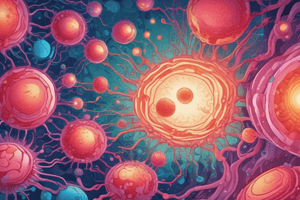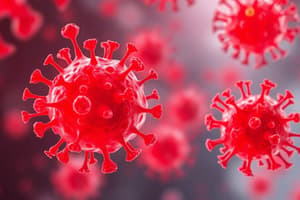Podcast
Questions and Answers
What is the primary mechanism by which leukocytes migrate through the endothelium during extravasation?
What is the primary mechanism by which leukocytes migrate through the endothelium during extravasation?
Leukocytes primarily migrate by squeezing between endothelial cells at intercellular junctions.
How do chemokines influence the movement of leukocytes during chemotaxis?
How do chemokines influence the movement of leukocytes during chemotaxis?
Chemokines stimulate leukocytes to move along a chemical gradient towards sites of injury.
What role do collagenases play in the process of leukocyte transmigration?
What role do collagenases play in the process of leukocyte transmigration?
Collagenases secreted by leukocytes help them pierce the basement membrane to enter extravascular tissue.
Define chemotaxis and explain its significance in the immune response.
Define chemotaxis and explain its significance in the immune response.
What types of agents serve as chemotactic agents for leukocytes?
What types of agents serve as chemotactic agents for leukocytes?
What is the first step in the process of phagocytosis by leukocytes?
What is the first step in the process of phagocytosis by leukocytes?
What roles do neutrophils and macrophages play in acute inflammation?
What roles do neutrophils and macrophages play in acute inflammation?
How does the phenomenon of opsonization enhance phagocytosis?
How does the phenomenon of opsonization enhance phagocytosis?
What developmental change allows leukocytes to move towards chemotactic agents?
What developmental change allows leukocytes to move towards chemotactic agents?
How does the type of leukocyte recruited to a site of inflammation depend on the stimulus?
How does the type of leukocyte recruited to a site of inflammation depend on the stimulus?
Describe the multistep process of leukocyte movement from blood vessels to tissue sites.
Describe the multistep process of leukocyte movement from blood vessels to tissue sites.
What are the major adhesion molecules involved in leukocyte rolling and adhesion, and what is their function?
What are the major adhesion molecules involved in leukocyte rolling and adhesion, and what is their function?
Explain the significance of cytokines like TNF and IL-1 in the recruitment of leukocytes during acute inflammation.
Explain the significance of cytokines like TNF and IL-1 in the recruitment of leukocytes during acute inflammation.
Discuss the lifespan of neutrophils and monocytes in the context of acute inflammation.
Discuss the lifespan of neutrophils and monocytes in the context of acute inflammation.
What role do anti-inflammatory cytokines like TGF-β and IL-10 play in the termination of the acute inflammatory response?
What role do anti-inflammatory cytokines like TGF-β and IL-10 play in the termination of the acute inflammatory response?
Describe the relationship between increased vascular permeability and the clinical signs of acute inflammation.
Describe the relationship between increased vascular permeability and the clinical signs of acute inflammation.
What is the significance of the term 'functio laesa' in the context of tissue damage during inflammation?
What is the significance of the term 'functio laesa' in the context of tissue damage during inflammation?
In the case of serous inflammation, what characterizes the fluid that accumulates in affected cavities?
In the case of serous inflammation, what characterizes the fluid that accumulates in affected cavities?
What morphological changes are observed in serous inflammation, particularly in skin blisters?
What morphological changes are observed in serous inflammation, particularly in skin blisters?
Explain how a fibrinous exudate forms during inflammation and under what conditions it typically occurs.
Explain how a fibrinous exudate forms during inflammation and under what conditions it typically occurs.
What are the reactive oxygen species (ROS) primarily produced within the phagolysosome by neutrophils?
What are the reactive oxygen species (ROS) primarily produced within the phagolysosome by neutrophils?
How does inducible nitric oxide synthase (iNOS) contribute to microbial degradation in macrophages?
How does inducible nitric oxide synthase (iNOS) contribute to microbial degradation in macrophages?
What is the role of myeloperoxidase (MPO) in neutrophils during the immune response?
What is the role of myeloperoxidase (MPO) in neutrophils during the immune response?
Describe the transition of dominant leukocyte populations during acute inflammation.
Describe the transition of dominant leukocyte populations during acute inflammation.
What functions do activated leukocytes, especially macrophages, perform beyond phagocytosis?
What functions do activated leukocytes, especially macrophages, perform beyond phagocytosis?
Explain how activated macrophages can influence collagen synthesis.
Explain how activated macrophages can influence collagen synthesis.
What causes neutrophils to undergo apoptosis and disappear from the inflammatory site?
What causes neutrophils to undergo apoptosis and disappear from the inflammatory site?
What substances are released from neutrophil granules that aid in microbial degradation?
What substances are released from neutrophil granules that aid in microbial degradation?
How do activated leukocytes respond to the presence of cytokines?
How do activated leukocytes respond to the presence of cytokines?
What is the role of phagocytic vacuoles in the immune response?
What is the role of phagocytic vacuoles in the immune response?
Flashcards
Leukocyte Recruitment
Leukocyte Recruitment
The process where white blood cells (WBCs) move from blood vessels into tissues, guided by chemical signals, to fight infections or heal injuries.
Neutrophils
Neutrophils
A type of white blood cell (WBC) that is the first responder to bacterial infections, arriving within the first 6-24 hours.
Macrophages
Macrophages
A type of white blood cell (WBC) that arrives later, after 24-48 hours, to clean up debris and help tissue repair.
Adhesion Molecules
Adhesion Molecules
Signup and view all the flashcards
Selectins
Selectins
Signup and view all the flashcards
Integrins
Integrins
Signup and view all the flashcards
Leukocyte Transmigration
Leukocyte Transmigration
Signup and view all the flashcards
Chemotaxis
Chemotaxis
Signup and view all the flashcards
Chemotactic Agents
Chemotactic Agents
Signup and view all the flashcards
Phagocytosis
Phagocytosis
Signup and view all the flashcards
Opsonins
Opsonins
Signup and view all the flashcards
Phagocytic Receptors
Phagocytic Receptors
Signup and view all the flashcards
Opsonization
Opsonization
Signup and view all the flashcards
Chemokines
Chemokines
Signup and view all the flashcards
Phagosome
Phagosome
Signup and view all the flashcards
Phagolysosome
Phagolysosome
Signup and view all the flashcards
Reactive oxygen species (ROS)
Reactive oxygen species (ROS)
Signup and view all the flashcards
Myeloperoxidase (MPO)
Myeloperoxidase (MPO)
Signup and view all the flashcards
Inducible nitric oxide synthase (iNOS)
Inducible nitric oxide synthase (iNOS)
Signup and view all the flashcards
Reactive nitrogen species (RNS)
Reactive nitrogen species (RNS)
Signup and view all the flashcards
Cytokines
Cytokines
Signup and view all the flashcards
Growth factors
Growth factors
Signup and view all the flashcards
Enzymes that remodel connective tissues
Enzymes that remodel connective tissues
Signup and view all the flashcards
Termination of Acute Inflammation
Termination of Acute Inflammation
Signup and view all the flashcards
Anti-inflammatory Cytokines
Anti-inflammatory Cytokines
Signup and view all the flashcards
Serous Inflammation
Serous Inflammation
Signup and view all the flashcards
Fibrinous Inflammation
Fibrinous Inflammation
Signup and view all the flashcards
Pain (Dolor) in Inflammation
Pain (Dolor) in Inflammation
Signup and view all the flashcards
Swelling (Tumor) in Inflammation
Swelling (Tumor) in Inflammation
Signup and view all the flashcards
Study Notes
Acute Inflammation Pathogenesis
- Learning Objectives: Students will be able to evaluate leukocyte recruitment, understand the role of neutrophils and macrophages in eliminating pathogens, classify acute inflammation types, and correlate inflammation subtypes with clinical conditions.
Leukocyte Recruitment
- Neutrophils and macrophages are recruited to sites of inflammation to recognize pathogens and damaged tissue, eliminating them and facilitating repair.
- The type of leukocyte recruited depends on the initial stimulus and inflammation duration:
- Bacterial infections primarily recruit neutrophils.
- Viral infections recruit lymphocytes.
- Allergic reactions increase eosinophils.
- Hypersensitivity reactions lead to mixed infiltrates.
- Necrosis initially induces a neutrophilic response, transitioning to monocytes after 24-48 hours.
Leukocyte Movement
- Leukocytes move from blood vessels to tissue in a multi-step process:
- Margination, rolling, and adhesion to endothelium.
- Transmigration across endothelium.
- Migration towards chemoattractants (chemotaxis).
- Apoptosis of neutrophils (within 24-48 hours), while monocytes survive longer.
Leukocyte Adhesion
- Leukocyte rolling, adhesion, and transmigration are driven by interactions between complementary adhesion molecules on leukocytes and endothelium.
- Important adhesion molecules include selectins (initiating weak interactions), and integrins (for firm adhesion).
- Cytokines like TNF and IL-1 enhance adhesion molecule expression.
Leukocyte Transmigration
- Leukocytes migrate through the endothelium by squeezing between cells at endothelial junctions.
- They traverse the basement membrane after secretion of collagenases.
Chemotaxis
- Chemotaxis is the directional movement of leukocytes along a chemical gradient guided by chemoattractants (e.g., bacterial products, cytokines).
Phagocytosis
- Phagocytosis is the process of recognizing, attaching, engulfing, and destroying pathogens.
- Phagocytic receptors on leukocytes recognize microbes, and opsonins (like IgG and C3b) enhance recognition.
- The ingested material is destroyed by reactive oxygen species (ROS), reactive nitrogen species (like NO), and lysosomal enzymes.
Role of Neutrophils and Macrophages
- Neutrophils and macrophages contain granules with enzymes, lysozyme, myeloperoxidase, and anti-microbial proteins; they degrade microbes, dead tissues, and contribute to tissue damage.
ROS and Nitric Oxide Production
- ROS (like hydrogen peroxide, hypochlorite, and hydroxyl radical) are produced within the phagolysosome; they are potent antimicrobial agents.
- NO is produced by inducible nitric oxide synthase (iNOS); it reacts with superoxides to create peroxynitrite, damaging microbial lipids, proteins, and nucleic acids.
Other Leukocyte Functions
- Activated leukocytes, predominantly macrophages, produce cytokines to amplify/limit inflammation, growth factors stimulating tissue repair (e.g., fibroblasts, collagen), and enzymes that remodel connective tissues.
Termination of the Inflammatory Response
- Inflammatory mediators are produced transiently and are eliminated; stop signals (e.g., anti-inflammatory cytokines like TGF-β and IL-10) regulate inflammation.
- Signs of acute inflammation include vascular dilation, leukocyte & fluid accumulation in tissues.
Serous Inflammation
-
Exudation of cell-poor fluid into spaces, often from body cavities (e.g., pleura, peritoneum).
-
Fluid is not typically infected.
- Examples include skin blisters resulting from burns or viral infections, or effusions in body cavities.
Fibrinous Inflammation
- Large increase in vascular permeability results in exudation of high-molecular weight proteins (such as fibrinogen).
- Fibrinous exudate forms a meshwork/coagulum.
- Occurs in lining of body cavities like meninges, pericardium, and pleura.
Purulent (Suppurative) Inflammation
- Characterized by pus production
- Result of pathogenic bacteria, particularly those producing liquefactive tissue necrosis (e.g., staphylococcus).
- Localized collections of pus (abscesses) are common outcomes.
Ulcers
- Ulcers are tissue defects resulting from sloughed necrotic tissue, often in areas with chronic inflammation (e.g., stomach, duodenum, lower extremities).
Studying That Suits You
Use AI to generate personalized quizzes and flashcards to suit your learning preferences.




